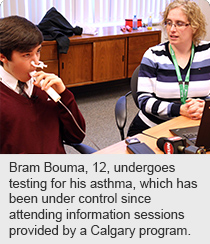
February 4, 2013
Story by Janet Mezzarobba; Photo by Colin Zak
Every since he was a little boy, a cold meant one thing for 12-year old Bram Bouma: an asthma attack.
“I always knew when Bram was sick, chances were we’d be awakened several times at night by Bram having trouble breathing and needing help with his medications,” says mom Tamara Cohos. “On several occasions, it was so bad, a trip to the emergency room was the only thing I knew would help.”
Now, Bram and other children with asthma are breathing a little easier thanks to an Alberta Health Services (AHS) program in the Calgary Zone that has greatly reduced their need for emergency department care and hospitalization.
The program – believed to be the first of its kind in Canada – invites patients and their families to one-hour education sessions with certified respiratory educators, who share information about asthma diagnosis, triggers, medication and devices. The educators also develop personalized ‘action plans’ to help each family keep asthma under control.
“Since Bram attended the one-hour session, we haven’t had to visit the emergency department once,” says Cohos. “It has helped restore normalcy within our family.”
The Community Pediatric Asthma Service was launched in 2005 with the goal of helping patients and their families better manage the chronic condition, and current statistics show the service is meeting its goal.
About 1,350 children visited Calgary’s Alberta Children’s Hospital (ACH) emergency department last year for an asthma-related concern, down from nearly 2,975 seven years ago, a 54 per cent decrease. During the same period, the number of asthma-related hospital admissions to ACH has also dropped – from 303 to 169, a 44 per cent decrease.
“Asthma was one of the top reasons for pediatric emergency room visits and inpatient admissions for children aged one to nine in the Calgary Zone of AHS,” says pediatric respirologist Dr. Mary Noseworthy, Asthma Director of ACH. “Despite a growing pediatric asthma population in the Calgary Zone, pediatric asthma visits to the Emergency Department at ACH have decreased from the second most common reason in 2005 to the ninth. This service is a tremendous success.”
To date, the service’s five respiratory educators have delivered more than 11,000 sessions across the Calgary Zone to patients and their families, as well as services to family physicians, physician trainees, community health nurses, pharmacists, teachers and daycare staff.
“We have made great strides in educating health providers in the community, allowing more children with asthma to be managed close to home rather than the hospital,” says program co-ordinator Shirley van de Wetering.
Dr. Noseworthy says this means patients with less severe asthma can now be put directly into the care of community health providers rather than visiting the specialty clinic at ACH.
“It’s virtually eliminated wait lists for asthma patients to see a specialist,” she says.
AHS’ Respiratory Clinical Network is sharing province wide advances in pediatric asthma care, including the work of this clinic, for the benefit of all Albertans.
The Respiratory Clinical Network is also piloting a childhood asthma care pathway at Medicine Hat Regional Hospital with the goal of rolling it out to several other hospitals in the AHS South Zone this spring.